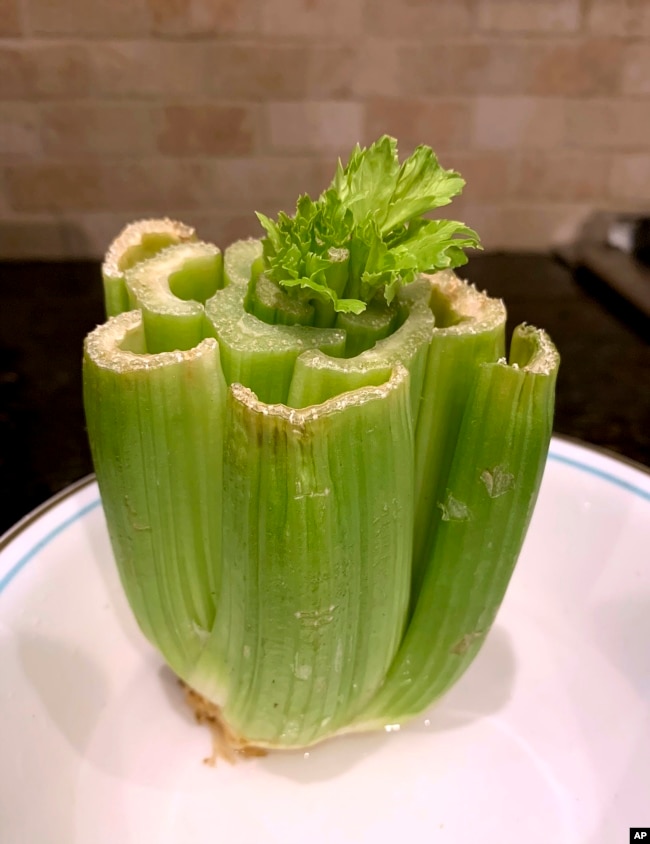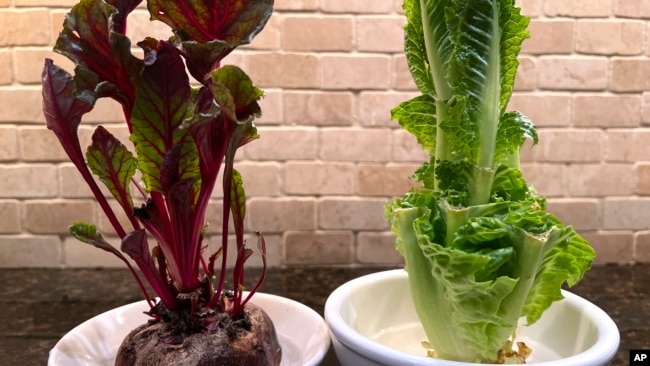さつまいもを半分切って水に浸けていたことがあったのですが、観賞用として素敵な姿と葉っぱに育ちました。
このGardening方法、やってみたいですね♫
聞いているととても簡単そうなのですが、まず根っこ付きをゲット!!
一回だけでも再生できて食べられたらこんなに嬉しいことはありませんもの。
VOAで英語を学びましょう!!
廃棄物を減らし、お金を節約するための野菜の再栽培(和訳)
Regrow Vegetables to Reduce Waste, Save Money
October 04,2022
ガーデニングは、leftover materials余ったものを再利用する自然な方法です。例えば、残った植物を使って土を豊かにすることは、compostingコンポストとも呼ばれ、食べきれなかった食品を再利用する良い方法です。
調理に使わなかった植物の部分から食材を育てることも、ゴミを減らして節約になります。
野菜を準備する際、野菜の底や上部を捨てたりコンポストする代わりに、窓際で葉物野菜などに育てることができます。ビーツ、セロリ、ネギとニラ、ロメインレタスなどの農産物は、この方法で再生させることができます。
これらの方法では、庭でうまく育つ植物を育てることはできないので、注意することが重要です。植物を再生させることは、若く成長した苗の代わりすることは良い方法ではありません。しかし、夕食の一品や二品に加えるおかずには十分な青菜ができる可能性があります。そして、植物を再生させることは楽しいプロジェクトになります。
残った野菜は、日光をたくさん浴びるとよく育ちます。水は少しぬるめのものを使い、雑菌が繁殖しないように1~2日おきに取り替えます。水に浸かっている部分が多少slimyぬるぬるになっても気にしないでください。ただし、株全体が茶色く変色してきたら、コンポストに捨ててやり直しましょう。
ビーツ
ビーツは、2つのおかず:大きな根とおいしい青菜が食べられるので、再生させるのに適している植物です。beetrootビーツを室内で挿し木から再生させることはできませんが、葉野菜を多く再生させることは可能です。
その方法は、ビーツの上部4センチほどを切り落とし、切り口が水に浸かる程度の水を入れた皿に切り口を下にして置きます。
数日で上部から新しい葉が再生されます。そして、2週間ほどで収穫を始めることができます。この方法は、似たような野菜であるパースニップやカブでも有効です。
セロリ
セロリの場合は、株の頭の下の部分を8センチほど切り落とします。次に、8センチメートルの一番下の部分をごく薄く切り落とします。それを容器に裏返しに入れ、5cmの水を注ぎます。わずか数日で中心部から新芽が出てきます。
ネギとニラ
ネギとニラの場合は、茎の下から白い部分を切り取ります。2.5cmの水を張った容器に、根元を下にして挿します。茎が容器からはみ出したら、大きめの容器に移し替える。2週間ほどで収穫できるようになります。
ロメインレタスは、株元を8センチほど切り落とし、外側の葉を取り除きます。8cmの”芯”を、1cm強の水を入れた容器に入れます。
1週間もすれば、中心から小さな芽が出てきます。成長するにつれて、芯の外側の葉の一部が茶色くなるのは正常なことです。それらを取り除く。中心部が十分な大きさになったら、その部分を切り取って楽しみます。あとは、もっと大きくなるのを待つだけです。
Regrow Vegetables to Reduce Waste, Save Money
Gardening is a natural way to reuse leftover materials. For example, using leftover plant material to enrich soil, also called composting, is a good way to reuse uneaten food.
Growing food from parts of plants not used in cooking also reduces waste and saves money.
Instead of throwing away or composting the bottoms or tops of vegetables when preparing them, you can grow them into leafy greens or other produce right in front of your window. Produce like beets, celery, scallions and leeks, and romaine lettuce can be regrown in this way.
It is important to note that these methods are not likely to produce plants that will grow well in your garden. Regrowing plants is not a good way to replace young, growing seedlings. But they are likely to make enough greens for side dish to add to a dinner or two. And regrowing plants can be a fun project.
Leftover produce will grow best with a lot of sunlight. Use slightly warm water and replace it every day or two to avoid the growth of bacteria. Do not worry if the part of the plant under water becomes a bit slimy. However, if the whole plant starts to turn brown, throw it in the compost and start over.
Beets
Beets are a good plant to regrow because they provide two side dishes: the large root and the tasty greens. You cannot regrow a beetroot indoors from a cutting, but you can regrow more leafy greens.
To do so, cut off the top four centimeters or so from a beetroot and place it cut-side down in a dish that contains just enough water to keep the cut end under water.
New leaves will regrow from the top within a few days. And you can start harvesting them in two weeks or so. This method also works with the similar vegetables, parsnips and turnips.
For celery, cut eight centimeters off the bottom of a head of the plant. Then, cut off a very thin piece from the very bottom of the eight centimeter piece. Place it right-side up in a container and pour in five centimeters of water. New growth will appear from the center in just a few days.
Scallions and leeks
For scallions and leeks, cut the white part from the bottom of the stalk. Then place it root-side-down in a container holding 2.5 centimeters of water. If the stalk outgrows the container, move it to a larger one. New growth will be harvestable in about two weeks.
Romaine lettuce
For romaine lettuce, cut eight centimeters off the bottom of a head of the plant, then remove its outermost leaves. Place the eight-centimeter “heart” in a container to which you have added a little over a centimeter of water.
Within a week, a small growth will appear from its center. As it grows, it is normal for some of the heart’s outer leaves to turn brown. Remove them. When the center part is large enough, cut off that part and enjoy. Then, just wait for more to grow.
Words in This Story
dish – n. a shallow container that you cook or serve food in
slime – n. a thick, slippery liquid
stalk – n. a thick or tall stem of a plant

